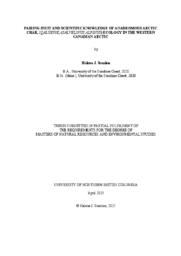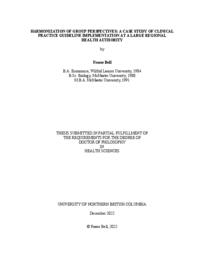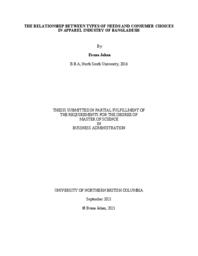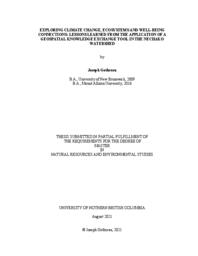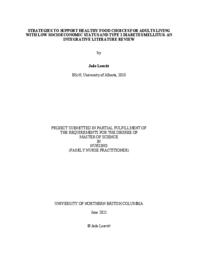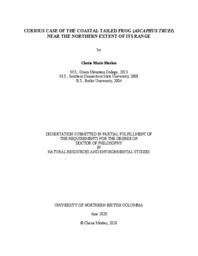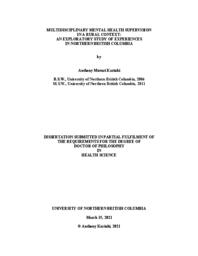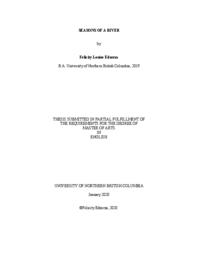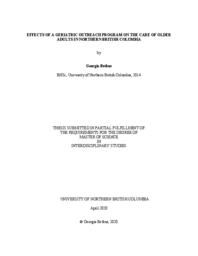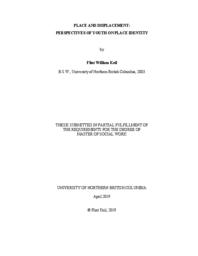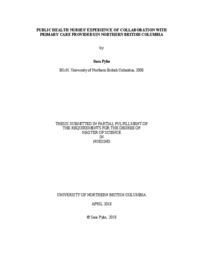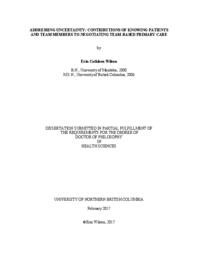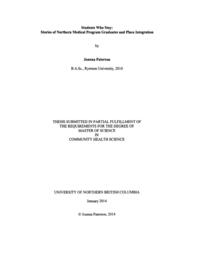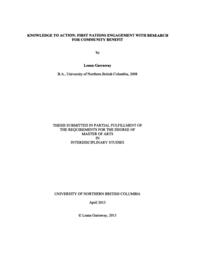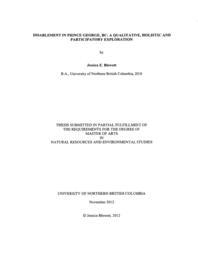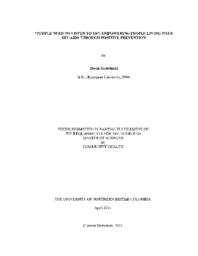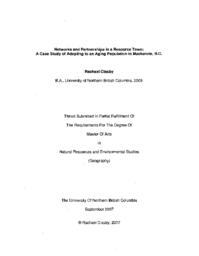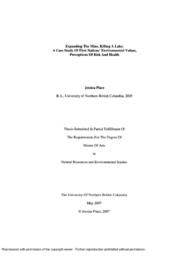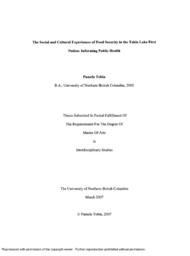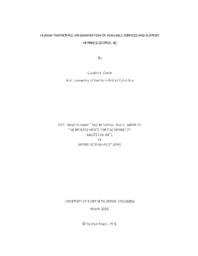Hanlon, Neil
Person Preferred Name
Neil Hanlon
Related Works
Content type
Digital Document
Origin Information
Content type
Digital Document
Origin Information
Content type
Digital Document
Description / Synopsis
The Canadian population is aging, and rates of obesity are also on the rise. These demographic changes have implications for the long-term care (LTC) system in Canada that need to be better understood, yet little is known about the population with obesity in Canadian LTC. In this thesis, an exploratory analysis of residents newly entering LTC between 2010 and 2020 is provided. Cross-tabulations and chi-squared statistical testing (p≤0.001) were employed to analyze retroactive, consecutive cross-sectional initial assessment data (N=350,348) from the Canadian Institute for Health Information’s (CIHI) Community Care Reporting System (CCRS) to explore the levels of obesity, demographic characteristics (age, sex, primary language, rural or urban previous residency), rates of health conditions, and independence and assistance levels of activities of daily living (ADLs). Over the full study period, the rate of obesity for the population entering LTC was 19%, and 7% entered with at least class II obesity (≥35 kg/m2). Rates of obesity and BMI obesity categories tended to increase incrementally over the course of the study period. Those entering LTC with obesity were more likely to be younger, female, English/French speaking, and arriving from rural areas. Individuals with obesity had lower rates of dementia and higher levels of independence when performing ADLs. They also exhibited higher rates of diabetes and a greater need for two+ person assistance for ADLs. This thesis begins to fill in the gap in our understanding of the population with obesity in LTC, providing a broad picture of the heterogeneous nature of the population, including important differences in health and ADL profiles across the three obesity BMI categories (i.e., classes I-III).
Origin Information
Content type
Digital Document
Description / Synopsis
Policy makers, health industry leaders, clinicians and researchers struggle to understand how new evidence-based practices, including Clinical Practice Guidelines (CPGs), can be implemented more quickly and more consistently. This retrospective qualitative case study explored sepsis CPG implementation at a British Columbia Regional Health Authority (RHA) between 2011-2017 to understand how individuals and teams with various functions and decision-making purviews come together to implement a prioritized CPG in a large RHA. The study was informed by practice theory and designed to provide practical guidance as to how CPG implementation might be better supported. Interviews involved 38 participants reflecting three functional groups: academics, regional managers and support staff, and clinicians. Over 350 documents and implementation process and outcome data were analyzed. The CPG implementation process was dynamic, involving different activities and intensities of involvement of individuals from each of the three groups. The three groups each behaved in a manner consistent with what some practice theorists call a community of practice. Individuals from each community of practice (COP) had a different perspective about the implementation along five dimensions (focus and rationale, vision, priority, appropriate balance and application of power, and goals, strategies and actions to be taken). The different COPs undertook actions that were consistent with their own COP perspective but not sufficiently aligned to ensure adherence to the CPG. The result was a discordant, and unsuccessful implementation. CPG adherence was not achieved. The differences in perspectives among the three COPs were substantial and appeared to have been deeply rooted in the beliefs, functions, experiences, and day-to-day realities of each of these groups of participants. The discordance in the implementation resulted from an insularity of each COP from the others, brought about by inadequate engagement among participants; insufficient connections across COPs to support shared understanding and alignment of action. Without some intervention, differences in perspectives will prevail and discordance is the likely outcome of any complex CPG implementation. This dissertation proposes the novel concept of harmonization as a means of achieving more successful CPG implementation; a process intended to reduce insularity of individual COPs within and beyond a RHA. Harmonization is conceptualized as a process comprised of many harmonizing activities that support engagement, relationship-building and explicit reflection and reconciliation of key differences in perspective among the three COPs. As a relational process, harmonization is largely determined by longstanding, contextual factors that support connections and collaboration among COPs. Widely engaging, horizontal, service-oriented improvement structures (with clear supporting roles and processes) establish a foundation for harmonization. Ongoing local interprofessional learning and improvement activities are essential to ensuring that the service improvement benefits from strong clinical engagement. RHA managers, particularly clinical managers, can support harmonization by encouraging open sharing of perspectives and managing in a way that is responsive to the realistic ebbs and flows of the implementation process. Harmonization integrates and builds upon many known CPG implementation determinants and strategies to bring a practical focus for future research and action.
Origin Information
Content type
Digital Document
Description / Synopsis
Glaciers hold 1.7% of the Earth's total water supply, but they contain 68.7% of its freshwater. Given the global warming trend, accurate and recent inventory is necessary to assess glacial changes over time. However, frequent cloud and debris cover often make it difficult to determine the glacier's exact edge. Multispectral Landsat 8 imagery along with data from the Global Land Ice Velocity Extraction (GoLIVE) project are combined to to create a Bayesian multivariate general additive model of the glaciers surrounding Mount Rainier, with Autoregressive Moving Average (ARMA) and Gaussian processes used to model the temporal and spatial autocorrelations. Using root mean square error and Watanabe-Akaike information criterion, all 42 combinations of ARMA models up to 4 total parameters and exponential, Matérn 1/2 and spherical covariance kernels were compared. The ARMA(3,1) processes with the exponential Gaussian process kernel was determined to be the best fit model. Gaussian mixture models, hierarchical clustering, hard and soft K-means clustering, and support vector machines are used to classify the posterior distribution. The hard K-means algorithm was the best classifier, and it accurately predicted 85.1% of the glaciers, compared to 68.8% from a univariate classification on the Red/SWIR band ratio.
Origin Information
Content type
Digital Document
Description / Synopsis
Consumer behavior signifies the way of people’s purchasing and consuming products and services. It is a hotbed of research which is intensely associated with human psychology and is essential for companies that are trying to sell their products or services to as many consumers as possible. Since various facets of consumers’ lives affect what they purchase and why they purchase, research on consumer behavior resolves the issues of understanding – how individuals respond to advertising and marketing, individuality – if the process can determine consumers’ personalities, social status, decision-making process. Consumer behavior research is important to determine how best to sell products or services by influencing consumers’ fears, their least healthy habits or their worst tendencies. This study has examined the relationship between consumer needs and consumer purchase behavior in terms of consumer choices of Bangladeshi customers for apparel market. Types of consumers’ choices and types of consumers’ needs are associated with each other. Types of needs are the underlying determinant of types of choices to satisfy consumers’ apparel necessity and these three categories of needs, that are recognised to satisfy apparel necessity (i.e. functional needs, social needs and experiential needs), are fulfilled by consumers through three recognised categories of choices (i.e. choice freedom, choice difficulty and choice confidence). Different categories of consumers have different types of needs and they behave differently while purchasing clothes, therefore, this study has figured out how consumers of Bangladesh make their choices according to their needs in apparel purchases. This study also examined how income levels work as a moderator while consumers make decisions. The purpose of this thesis is to shed light on the relationship of the consumers’ needs and choices. The key objective is to investigate how the correlation between consumers’ needs and choices influences the insights of consumers and their decision-making process. This study also inspected the affiliation between the needs and choices for the population with respect to certain key questions. Consequently, it identified a better understanding of the links between needs and choices and set a special consideration of how choices interact with various situations which is very important to sell the apparel products in best way. The study employed a survey research design which is quantitative in nature. Quantitative survey quantifies the problems by generating numerical data which can be converted into functional statistics and it is mostly used to measure attitudes, opinions, behaviors and any other defined variables (DeFranzo, 2011). The data was collected through a structured Likert-scale questionnaire which fulfilled the quantitative research nature. The included questions were related to the types of needs and choices theories, with focus on consumers’ purchase behavior. Therefore, it was able to investigate quantitatively due to the nature of the research. Respondents completed the questionnaire which was administrated via online electronic form through SurveyMonkey. After collecting the data, it ran ordinal regression models on the basis of dependent and independent variables of the questionnaire and that provided a clear indication of consumers’ actual preference structure. This research paper was demonstrated with the broad overview about the consumers’ choices according to the types of their needs. The study found that types of needs are positively associated with types of choices and low-income level and high-income level have decreased and increased impact accordingly with the positive relationships of needs and choices. The findings of the paper offer some valuable considerations for related theories, especially on topic of consumers’ purchase behavior by highlighting the contextual differences between needs and choices and by highlighting the other influencing factors associated with these. It contributes to build up new concepts of consumer purchase behavior theory in terms of branding theory and consumers’ needs and selection process also demonstrates that how types of needs influence consumers’ purchase decision through types of choices. Moreover, new concepts or strategies and psychological explanations of consumers help the managers to sell their products appropriately.
Origin Information
Content type
Digital Document
Description / Synopsis
The Nechako Watershed is a large system in northern BC that exemplifies the challenge of integrating information across climate, environment and well-being. This research responded to this need with the goal of enhancing how information about the Nechako Watershed is communicated and shared. Informed by the development of a geospatial ‘portal’ tool in northern BC, this research sought to establish the Integrated Watershed Research Group (IWRG) Portal, gain insight on establishing accessible knowledge exchange strategies, and identify its perceived benefits and limitations. The research had two phases. Phase I involved working with a development team to understand this tool, testing, establishing the IWRG Portal, finding and formatting content. Phase II brought members of the Portal User Research Group together to further refine the IWRG Portal and content through scoping discussions, workshops, and a focus group. Thematic analysis was used to code and analyze the transcribed focus group. The research identified benefits of the portal with how it dealt with complexity and its integrative features. Limitations were also found, including the need for intentional framing of data, a steep learning curve, and the need for an internet connection. Analysis also identified the need to tailor content for specific audiences. The research has shown that tools such as the IWRG Portal can create new pathways to understanding and finding information. The research has also identified paths for further refinement and development of the portal tool by expanding the user base and continuing to evaluate the effectiveness of this tool in various contexts.
Origin Information
Content type
Digital Document
Description / Synopsis
Type 2 diabetes mellitus (T2DM) is an increasing concern in Canada, with low socioeconomic status being a major risk factor. This review explores strategies to improve food access that promote healthy food choices among people experiencing food insecurity and living with T2DM. Whittemore and Knalf’s (2015) integrative literature review methodology was used to extract and analyse the evidence. Four key strategies emerged: 1) promoting healthy food affordability through incentives and disincentives, 2) understanding effective and ineffective food interventions, 3) enhancing nutritional education in the standard of care, and 4) manifesting empowerment through self-efficacy and diabetes management. These strategies can be applied by nurse practitioners within primary care. Aligned with a population health approach, they can direct practice, education, and research through healthy public policy focused on reducing the incidence of T2DM, particularly in people experiencing food insecurity.
Origin Information
Content type
Digital Document
Description / Synopsis
Ascaphus truei, an ancient species of frog, migrated into British Columbia, Canada, following the last ice age. A. truei is of conservation interest because forestry practices, and the associated infrastructure, may reduce habitat quality. There is also concern that a warmer and drier climate will change the distribution and abundance of this species. I used two genetic methods, microsatellites and next-generation sequencing, to compare the genetic diversity of A. truei from the northern extent of its range in British Columbia, CA to southern Washington, USA. Both methods suggested a dramatic reduction in diversity across the northern portion of the species’ range. The phylogeography suggests a northern range expansion from a single refugium. I used DNA metabarcoding to compare the gut contents of larvae across three stream reaches and two development classes near the northern extent of A. truei's range. Gut contents differed between stream reach but did not differ among development class. Wetted width and ultimately stream volume may influence differences in gut content among stream reaches. I also quantified the relationship between an index of larvae density and environmental factors hypothesized to influence population density near the northern extent of the range. I assessed the segregation of larvae at various developmental stages. Wetted width and wetted depth correlated with differences in the abundance of larvae. Older developmental stages were captured in stream reaches with greater slopes than younger stages. Management should minimize modifications of stream structure, such as in-stream siltation due to road building. We should maintain habitat connectivity and gene flow to ensure the continued migration and adaptive capacity of A. truei.
Origin Information
Content type
Digital Document
Description / Synopsis
The purpose of this study was to better understand how multidisciplinary mental health supervision might work in rural remote settings. There is a need for supervisory approaches that address the unique contextual challenges in rural and remote multidisciplinary service delivery, such as management approaches, isolation, and lack of support. This study focused on three areas linked to multidisciplinary mental health supervision: challenges and opportunities, role perception, and differences in approaches. This study also attempted to reconcile the core supervisory requirements with the contextual challenges. The few studies on rural remote supervision have primarily focused on general internal and external factors facing rural remote professionals. Despite its importance, knowledge of how multidisciplinary rural remote supervisors perceive and/or appreciate their roles is limited. This study was informed by social construction and symbolic interaction theories, and guided by three research questions: 1) What challenges and opportunities do mental health supervisors experience in northern British Columbia? 2) How do frontline workers, supervisors, and senior managers perceive the roles and activities of mental health supervisors in northern British Columbia? 3) How are supervisory approaches in various mental health disciplines different or similar in northern British Columbia? The research methodology was qualitative and the study design adopted an interpretive, social interactionist approach. Source triangulation enhanced both the credibility and transferability of the findings. The sources included three participant groups: frontline mental health workers, mental health supervisors, and senior mental health managers. Another triangulation source was the context and setting review of BC’s complex mental health jurisdictions. Triangulation was also achieved by interviewing participants who worked in different settings, organizations, and geographic locations. Thematic analysis was used for data analysis resulting in 11 manifest themes and the following five latent themes: Difficult, overwhelming responsibilities; stressful, complicated decision making; the endless campaign for professional leadership support; mentorship in remote practice; and a struggle in collaborative plurality. Most of the participants expressed the wish for more support in their professional work. The findings from this study provide employers with new insights into multidisciplinary supervisory work and also emphasize the need for practical and specific ideas for much needed support for rural remote supervisors.
Origin Information
Content type
Digital Document
Description / Synopsis
Seasons of a River is a fictional story about a woman looking back on her life. In her recollections she has to acknowledge and come to terms with the fact that her relationships with indigenous people in Canada have been inequitable and unbalanced. She realizes that she has been in the role of helper, of ally, and as such has perpetuated ideas of colonization and oppression, despite her good intentions. The protagonist, Annan, is in the process of trying to understand the complicated issues involved with the helping industry and her part within that industry. My introduction discusses the power differentials within allyship relations. I discuss how liberalism, at the root of the helping industry, although seen as a positive ideology, often perpetuates inequities and injustices when dealing with groups that are seen as “different.” I also discuss the importance of relationship building and listening and the need for quelling the tendency to assist others without consultation. This introduction and story also contain themes of ageism and how these attitudes are woven into the fabric of society in such a way as to internalize oppression and the idea of staying in one’s “place.” Ultimately, this story is about transformation.
Origin Information
Content type
Digital Document
Description / Synopsis
The Northern Health Authority’s Geriatric Outreach Program provides consultations with geriatric specialists in-person and through videoconference. With Canada’s population aged 65+ expected to increase over the next several years, there is precedent to explore service delivery methods and how they influence care of older adults. Using a multi-method research design, formal-care providers’ perspectives of the Geriatric Outreach Program were explored, and the outcomes and costs of in-person and videoconferencing components were compared. Results revealed that the program supports care of older adults by providing access to geriatric care closer to patients’ homes and by providing comprehensive care plans back to the referring general practitioners. Costs of videoconferencing consultations were lower than in-person costs due to the added expense of specialist’s travel, and videoconferencing also resulted in more new diagnoses, medication changes, further testing, and requests for follow-up. However, further research is needed to fully understand these differences in outcomes.
Origin Information
Content type
Digital Document
Origin Information
Content type
Digital Document
Origin Information
Content type
Digital Document
Origin Information
Content type
Digital Document
Origin Information
Content type
Digital Document
Origin Information
Content type
Digital Document
Origin Information
Content type
Digital Document
Origin Information
Content type
Digital Document
Origin Information
Content type
Digital Document
Origin Information
Content type
Digital Document
Origin Information
Content type
Digital Document
Origin Information
Content type
Digital Document
Origin Information
Content type
Digital Document
Origin Information


